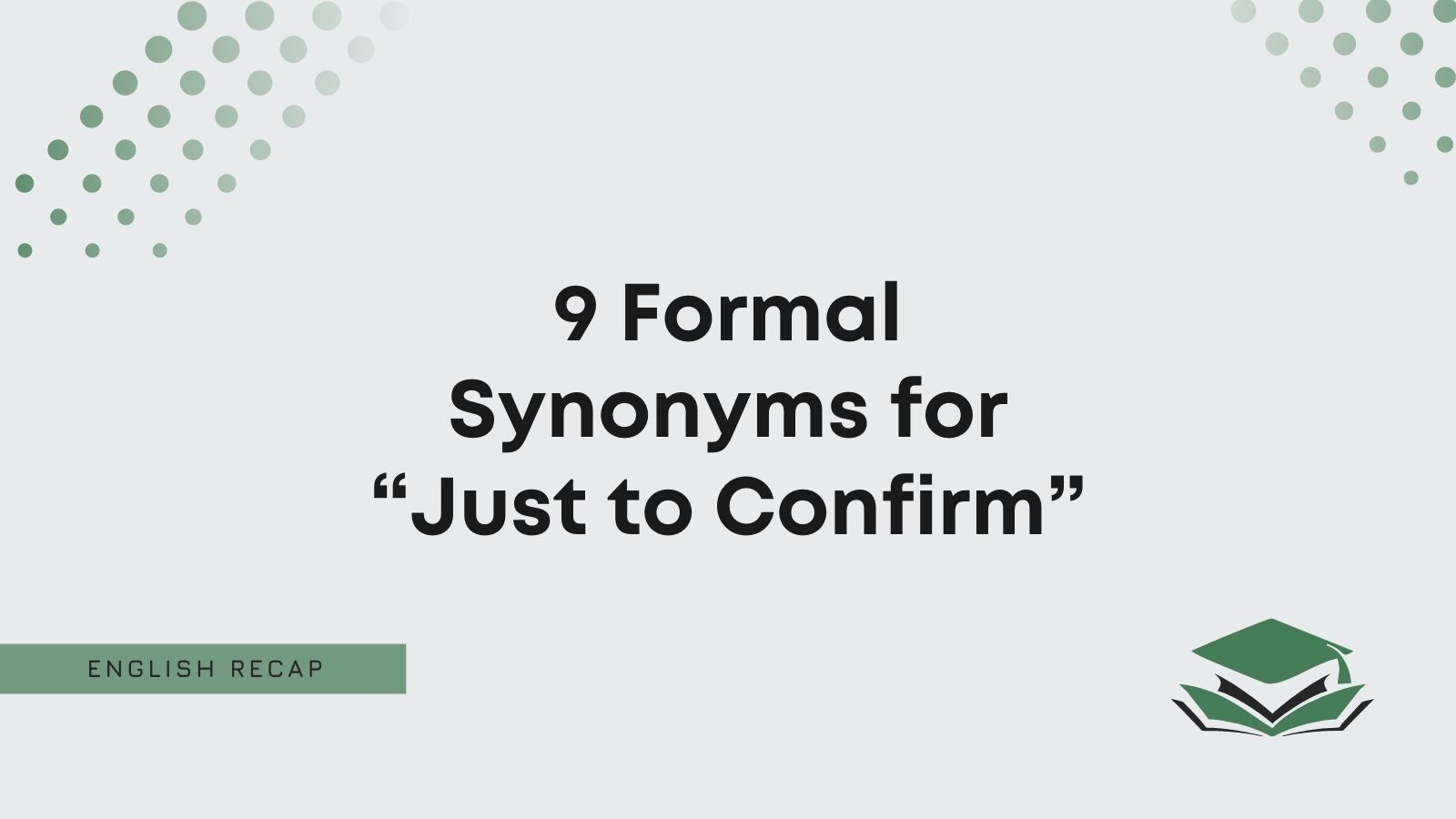You should always confirm information via email when you’re unsure about something. Perhaps you’re thinking about writing a simple confirmation email with “just to confirm.”
However, is this the most appropriate choice formally?
This article will look into formal synonyms for “just to confirm” to help you.
Is It Formal to Say “Just to Confirm”?
It is not formal to say “just to confirm.” Unfortunately, it is unprofessional because it is far too casual. You’ll find it only works in conversational situations or when emailing colleagues you’re friendly with.
With that said, it’s still a polite way to confirm something with an email or text message recipient. It shows you’d like to check on your plans before you go further with anything.
Here’s an example to show you how to use it:
Just to confirm with you, are we still on for Monday? I haven’t heard much about it.
Pros
- It’s very polite.
- It works well as a conversational and friendly confirmation.
Cons
- It does not work in professional contexts.
- It’s too casual to use in important email conversations.
So, “just to confirm” is not the most appropriate phrase to use formally. Luckily, there are plenty of alternatives available to make things more professional in your writing.
Keep reading to learn another way to say “just to confirm.” We’ve also provided examples for each one to help you.
What to Say Instead of “Just to Confirm”
- I would like to confirm
- I would like to check
- Writing to confirm
- I would like some confirmation
- To be sure
- To clarify
- To make sure
- To ensure I’m correct about this
- To be clear
1. I Would Like to Confirm
“I would like to confirm” is the best way to replace “just to confirm” in professional contexts. The difference might be subtle, but it’s incredibly effective when you use it correctly.
The formality comes from “I would like.” It shows politeness toward the recipient, making it an excellent choice when writing a formal confirmation email.
You should use it when emailing clients to find out the logistics of your meeting. It shows that you’d like to confirm all the facts before you continue with anything.
Here’s an email example if you’re still unsure:
Dear Carl,
I would like to confirm with you before I continue with the meeting. Are we meeting with both companies or just one?
Kind regards,
Stuart Edwards
2. I Would Like to Check
Another good formal way to say “just to confirm” is “I would like to check.” It shows that you’re keen to confirm the details of a meeting that’s coming up.
Using “check” is slightly more conversational than “confirm.” So, you should use it when emailing colleagues you trust. It shows you have a good relationship with them and want them to help you confirm a few things.
This email sample should clear a few things up:
Dear Hazel,
I would like to check whether there is anything else I need to add to my presentation. Can you tell me if it’s missing anything?
Thank you so much,
Billy Humor
3. Writing to Confirm
Many formal emails start with phrases like “I’m writing to” or “I’m emailing to.” In this case, we’re using “writing to confirm” at the start of a confirmation email to check the facts of a situation.
You should use it as a clear and direct way to confirm information. It shows the recipient that you trust them and want to know their thoughts. You may want to use it to email colleagues you are going to meet with over the next few days.
This example will also help you understand more:
Dear Brian,
I am writing to confirm that we are still on for our meeting tomorrow. Has anything changed with your schedule?
All the best,
Mr. Barkley
4. I Would Like Some Confirmation
Starting any professional email with “I would like” is often all you need to give off a more respectful tone. So, “I would like some confirmation” works really well to show that you’d appreciate it if the recipient could confirm some facts.
Generally, you would email your boss with a phrase like this. It shows you need to confirm a few things about the task you’ve been set. Then, you can be more confident in providing correct answers when people ask questions about your task.
Here’s a great sample email to help you with it:
Dear Carla,
I would like some confirmation about this before I pass any information on to querying customers.
Yours,
Joanna Scofield
5. To Be Sure
A great alternative to “just to confirm” is “to be sure.” It works well in business emails as it shows you want to confirm a few details before you finalize anything.
Generally, this works best when emailing clients about events. It shows you are working closely with them to ensure the event goes according to plan or schedule.
However, you might not have all the important details. That’s why you should email a client to find out if they can clarify anything before you are completely “sure.”
Why not refer to the following email sample:
Dear Sarah,
I would like to be sure about the situation. So, I am writing to find out what you know about the upcoming event.
Kind regards,
Robert Andrews
6. To Clarify
Clarification is key in professional emails. You should always ask questions to ensure you have all the relevant information. That’s where “to clarify” comes in.
It allows you to confirm everything with the recipient. Maybe you can use it when emailing coworkers about a meeting or situation that came up earlier in the week. It shows you’d like to know what they took away from the situation to confirm some details.
Check out the following email example to see how it works:
Dear Howard,
To clarify, did you tell them anything about our conversation with Mr. Taylor? I would like to know what you said if so.
Thank you so much,
Carl Pilkington
7. To Make Sure
“To make sure” is a great formal synonym for “just to confirm.” It shows you are writing to someone to ensure you have the correct information.
Generally, two pairs of eyes (or minds) are better than one. So, if you can email someone to ask them for confirmation and clarification, you should do so.
You may use it when emailing clients. It shows you might have a meeting planned with them and want to confirm a few details before you arrive.
This email example should show you more about it:
Dear Harry,
I am checking to make sure that we are still okay for our meeting tomorrow. Let me know if this still works for you.
All the best,
Suzanna Reid
8. To Ensure I’m Correct About This
It’s good to confirm things before you go around stating them as facts. “To ensure I’m correct about this” is a great example of this. It shows you want to confirm your information before you confidently start including it.
You may want to use it when emailing your boss. It shows you would like them to confirm something with you to see if you need to do it. Generally, your boss is going to know more about the situation than you, so they’re a reliable source.
This example will help you understand all you need to know:
Dear Joseph,
I am writing to ensure I’m correct about this. Do we have to attend the meeting tomorrow, or is it optional?
Kind regards,
Ben White
9. To Be Clear
Returning to a simpler synonym, you can use “to be clear” instead of “just to confirm.” It’s a great alternative in most formal emails because it shows that you want to clarify a few things.
You should use it when setting up meetings in the workplace. It shows that you want to know whether everyone is on the same page and can get in at the same time. Otherwise, you might have to change some things around and let everyone know the plan.
Don’t forget to check out this example as well:
Dear Catherine,
To be clear on my understanding, are we going to meet to discuss this tomorrow? My diary doesn’t have an entry for this.
Kind regards,
Joey Clark

